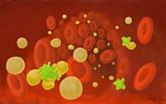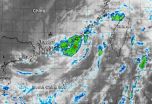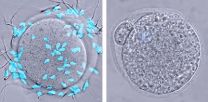E-cigarettes far less harmful than cigarettes, says Lancet researcher at INFORMS Conference
Rates alcohol most dangerous drug to public, heroin worst for individuals
2014-06-16
(Press-News.org) A London School of Economics researcher examining the public and private dangers of drugs argues against demonizing e-cigarettes in a presentation being given at a conference of the Institute for Operations Research and the Management Sciences (INFORMS). He also calls on public officials to recognize that alcohol causes greater harm than other recreational drugs and more public attention should be paid to controlling its harmful effects.
Lawrence D. Phillips, an emeritus professor at the London School of Economics, will present his research group's findings about the relative risks of different drugs at Advances in Decision Analysis, a conference sponsored by the INFORMS Decision Analysis Society (DAS). The conference takes place June 16-18 at Georgetown University in Washington, DC.
A recent workshop facilitated by Prof. Phillips led a group of researchers to write a letter to the World Health Organization advocating against the classification of e-cigarettes as tobacco. They argued that e-cigarettes should be classified as a device for fighting nicotine addiction. . " It is well known that 'people smoke for the nicotine, but die from the smoke'," he says.
In his upcoming presentation, Prof. Philips draws on a study about drugs in the United Kingdom he co-authored in 2010 that was published in The Lancet. "Drug Harms in the UK: A Multi-Criteria Analysis" has lessons that can be applied in the U.S. and across the world, he says.
The 2010 results are based on an expert panel that was called upon to use participants' judgment to assess the relative harm of 20 different drugs. Because the drugs are illegal and data is extremely difficult to obtain, the participants relied on their collective knowledge and experience to score the drugs and a decision analysis model to aggregate the judgments.
Similar results were obtained in 2013 among a group assessing drug risk in Europe. A .993 correlation between the two panels, which contained different sets of experts, is considered extremely high.
A 2013 expert panel about the relative harm of 12 nicotine products named cigarettes the most harmful but ranked e-cigarettes near the bottom, in ninth place. Prof. Phillips explores its results in his presentation at Georgetown University.
The various panels used decision analysis to determine psychological, physical and social harm to users and to those around them. Members of the United Kingdom's Independent Scientific Committee on Drugs scored 20 drugs on 16 criteria.
Decision analysis of the UK panel ratings showed that heroin, crack cocaine, and methamphetamine were the most harmful drugs to individuals (scoring 34, 37, and 32, respectively). Alcohol, heroin, and crack cocaine were the most harmful to others (46, 21, and 17).
Overall, alcohol was the most harmful drug (overall harm score 72), with heroin (55) and crack cocaine (54) in second and third places. Similar results were found when analyzing the continental Europe panel.
Several experts from the drug harm workshop, including The Lancet study's co-author David Nutt, the Edmund J Safra Professor of Neuropsychopharmacology and Head of the Department of Neuropsychopharmacology and Molecular Imaging at Imperial College London, have called on British and international health organizations like WHO to adjust their guidelines about dangerous drugs based on the findings.
In the 2010 paper, they write, "the present drug classification systems have little relation to the evidence of harm. They also accord with the conclusions of previous expert reports that aggressively targeting alcohol harms is a valid and necessary public health strategy."
Prof. Phillips notes the important role of judgment in quantitative models, particularly when there is limited data available, as was the case for these panels.
The 20 drugs rated in the studies were alcohol, amphetamines, anabolic steroids, benzodiazepines, buprenorphine, butane, cannabis, cocaine, crack, Ecstasy, GHB, heroin, ketamine, khat, LST, mephedrone, methadone, methamphetamine, mushrooms, and tobacco.
The combined research shows the important role for judgment in quantitative models, particularly when there is very little data available, as in research about illegal drugs. The decision science techniques provided new tools to reevaluate common perceptions and laws governing hazardous drugs.
INFORMATION:
This research was made public in conjunction with the INFORMS Decision Analysis Society (DAS).Formed in 1980 with a thousand current members, DAS promotes the development and use of logical methods for improving decision-making in public and private enterprise. For more information, visit http://www.informs.org/Community/DAS.
About INFORMS
INFORMS is the leading international association for professionals in analytics and operations research (O.R.). INFORMS advances research, and develops and promotes best practices in analytics and O.R. through collaboration, knowledge sharing, and professional development. INFORMS helps business, government, and other organization professionals make better decisions to drive value to their organizations and society. Our certification program (CAP®), highly cited publications, educational meetings and conferences, continuing education, industry and process focused networking communities, competitions, and recognition provide professionals with the knowledge and connections they need to achieve ever greater value for their organizations. The INFORMS Decision Analysis Society (DAS), a subdivision of INFORMS, is a leader in applying decision science to problems that affect business, public policy, and personal lives. Further information about INFORMS, analytics, and operations research is at http://www.informs.org or @informs and further information about the INFORMS Decision Analysis Society (DAS) is at https://www.informs.org/Community/DAS.
ELSE PRESS RELEASES FROM THIS DATE:
Lipids help to fight leukemia
2014-06-16
T cells use a novel mechanism to fight leukemia. They may recognize unique lipids produced by cancer cells and kill tumor cells expressing these lipid molecules. A study conducted by researchers at the University of Basel shows that a tumor-associated lipid stimulates specific T cells, which efficiently kill leukemia cells both in vitro and in animal models. The results have been published in the Journal of Experimental Medicine.
Leukemias are cancer diseases affecting blood cells . Acute leukemias prevent development of normal bold cells and thereby are severe life-threatening ...
Cellular force that drives allergy and asthma can be blocked by interferon
2014-06-16
DALLAS – June 16, 2014 – A mechanism that could underlie the development of cells that drive asthma and allergies has been uncovered by immunology researchers at UT Southwestern Medical Center.
Asthma and allergies are both driven by an inappropriate activation of the immune system, primarily a subtype of white blood cells known as T helper 2 cells, or Th2 cells. These cells are normally responsible for defense against parasites, but are also the main culprits behind the symptoms of asthma and allergies.
Dr. David Farrar, Associate Professor of Immunology and Molecular ...
Studies in family planning publishes special issue on unmet need
2014-06-16
NEW YORK, NY (16 June 2014) — Studies in Family Planning, a leading journal published by the Population Council, released "Unmet Need for Family Planning"—a special issue featuring ten articles, including a comprehensive introduction to the topic of unmet need. Distinguished researchers explore trends related to unmet need for contraception, and many articles point to practical strategies for increasing contraceptive knowledge and uptake, and for overcoming barriers that prevent women from practicing contraception.
"Unmet need has been an important indicator for measuring ...
NASA catches short-lived tropical cyclone Hagibis landfalling in China
2014-06-16
Tropical storm Hagibis only lived through 6 bulletins issued by the Joint Typhoon Warning Center in its short lifetime in the northwestern Pacific Ocean. The final bulletin was issued on June 15 at 1500 UTC (11 a.m. EDT) after Hagibis made landfall in China.
Hagibis was born in the South China Sea on June 14 at 0900 UTC (5 a.m. EDT) near 20.7 north latitude and 117.0 east longitude, about 183 nautical miles east-southeast of Hong Kong when a low pressure system quickly consolidated and maximum sustained winds jumped to 35 knots (40 mph/62 kph). Hagibis is the seventh ...
How sperm get into the zona
2014-06-16
Before it can fertilize an egg, a sperm has to bind to and bore through an outer egg layer known as the zona pellucida. Despite decades of research, some of the biological mechanisms behind this process remain unclear. A study in The Journal of Cell Biology now identifies the protein in the zona pellucida that sperm latch onto.
The zona pellucida protects the egg and the early embryo before implantation. Its structure seems simple—in humans it contains four kinds of glycoproteins, and in mice it only contains three. But researchers haven't been able to identify the sperm's ...
High number of fatalities despite unchanged level of armed conflicts
2014-06-16
At 33, conflicts in the world last year increased by one compared to 2012. This is reported by peace researchers at Uppsala University's Conflict Data Program. The number has remained stable over the past decade. 2012 saw an increase in the number of battle-related deaths with the number of casualties in Syria completely overshadowing any other ongoing conflict. In 2012, two out of five people dying in battles, died in Syria.
The new dataset is described by peace researchers at Uppsala University's Conflict Data Program (UCDP) in an article which will soon be published ...
Anxious children have bigger 'fear centers' in the brain
2014-06-16
Philadelphia, PA, June 16, 2014 – The amygdala is a key "fear center" in the brain. Alterations in the development of the amygdala during childhood may have an important influence on the development of anxiety problems, reports a new study in the current issue of Biological Psychiatry.
Researchers at the Stanford University School of Medicine recruited 76 children, 7 to 9 years of age, a period when anxiety-related traits and symptoms can first be reliably identified. The children's parents completed assessments designed to measure the anxiety levels of the children, ...
Stress early in life can increase the risk of overweight in adulthood
2014-06-16
There are indications that unborn children who are exposed to severe stress levels, have an increased risk of becoming overweight or developing obesity as adults.
This is shown by a new registry study from Aarhus University published in PloS ONE.
The researchers have previously shown that severe stress experienced by pregnant women can lead to weight problems for children between 10 and 13 years; however, a correlation between the mother's level of stress during pregnancy and the risk of developing overweight or obesity as an adult is new:
"Overall our results indicate ...
Wind turbine payback
2014-06-16
US researchers have carried out an environmental lifecycle assessment of 2-megawatt wind turbines mooted for a large wind farm in the US Pacific Northwest. Writing in the International Journal of Sustainable Manufacturing, they conclude that in terms of cumulative energy payback, or the time to produce the amount of energy required of production and installation, a wind turbine with a working life of 20 years will offer a net benefit within five to eight months of being brought online.
Wind turbines are frequently touted as the answer to sustainable electricity production ...
Coalition's deficit reduction has made UK tax base more regressive
2014-06-16
Taxation in the UK has become increasingly regressive since the financial crisis, particularly since the coalition government came to office, according to academics at the Sheffield Political Economy Research Institute (SPERI).
The latest evidence on tax revenue shows that progressive taxes such as income tax and capital gains tax contribute 54 per cent of total tax receipts, down from 58 per cent five years earlier. In contrast, regressive taxes such as VAT contribute 28 per cent of total tax receipts, an increase from 25 per cent.Tax
Research found that of all the ...
LAST 30 PRESS RELEASES:
Statins significantly reduce mortality risk for adults with diabetes, regardless of cardiovascular risk
Brain immune cells may drive more damage in females than males with Alzheimer’s
Evidence-based recommendations empower clinicians to manage epilepsy in pregnancy
Fungus turns bark beetles’ defenses against them
There are new antivirals being tested for herpesviruses. Scientists now know how they work
CDI scientist, colleagues author review of global burden of fungus Candida auris
How does stroke influence speech comprehension?
B cells transiently unlock their plasticity, risking lymphoma development
Advanced AI dodel predicts spoken language outcomes in deaf children after cochlear implants
Multimodal imaging-based cerebral blood flow prediction model development in simulated microgravity
Accelerated streaming subgraph matching framework is faster, more robust, and scalable
Gestational diabetes rose every year in the US since 2016
OHSU researchers find breast cancer drug boosts leukemia treatment
Fear and medical misinformation regarding risk of progression or recurrence among patients with breast cancer
Glucagonlike peptide-1 receptor agonists and asthma risk in adolescents with obesity
Reviving dormant immunity: Millimeter waves reprogram the immunosuppressive microenvironment to potentiate immunotherapy without obvious side effects
Safety decision-making for autonomous vehicles integrating passenger physiological states by fNIRS
Fires could emit more air pollution than previously estimated
A new way to map how cells choose their fate
Numbers in our sights affect how we perceive space
SIMJ announces global collaborative book project in commemoration of its 75th anniversary
Air pollution exposure and birth weight
Obstructive sleep apnea risk and mental health conditions among older adults
How talking slows eye movements behind the wheel
The Ceramic Society of Japan’s Oxoate Ceramics Research Association launches new international book project
Heart-brain connection: international study reveals the role of the vagus nerve in keeping the heart young
Researchers identify Rb1 as a predictive biomarker for a new therapeutic strategy in some breast cancers
Survey reveals ethical gaps slowing AI adoption in pediatric surgery
Stimulant ADHD medications work differently than thought
AI overestimates how smart people are, according to HSE economists
[Press-News.org] E-cigarettes far less harmful than cigarettes, says Lancet researcher at INFORMS ConferenceRates alcohol most dangerous drug to public, heroin worst for individuals



